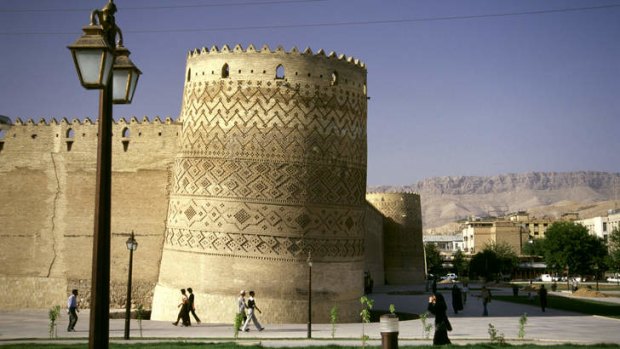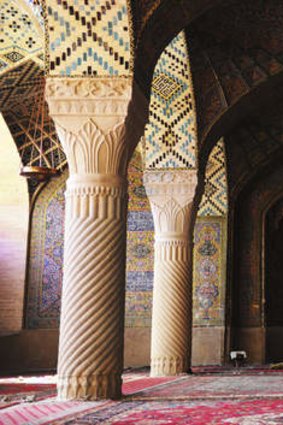
Karim Khan's citadel is the centrepiece of Shiraz.Credit: Alamy
One of our best-known wine varieties gets its name from an ancient Iranian city. Brian Johnston explores the original Shiraz.
As my long-distance coach trundles towards Shiraz over a red-clay desert, it's hard to believe this city was once renowned for vineyards and rose gardens. The highway snakes between barren hills, passing roadside teahouses where fairy lights are rock-strung for want of trees. Cars fart and honk, and shabby one-night hotels promise only dust and depression to itinerant salesmen.
Yet the cracked concrete suburbs conceal Shiraz's soft centre. Soon roses, wanton in the dust, bloom from roadside flowerbeds. Monuments and minarets appear, crumbling but glorious. They catch the pink rays of sun before neon gleams. Lanterns fizz from candied-seed stalls, lighting me from bus station to hotel. Later, I find a restaurant joyous with family conversation, where waiters flit with tureens of saffron rice and spiced lamb.

Prayers in Nasir al-Mulk Mosque.Credit: Getty Images
Shiraz is a friendly, sophisticated city, built on poetry and centuries of trade. Its 1600-metre altitude gives it a soothing climate. Tree-lined streets and parks invite shady wandering. Once, before the mad mullahs took over, it was noted for wine and whimsy.
"The Shirazi are people whose thoughts dwell upon passionate love, and shades of trees. They are people of sleepy eyes and melting moods," wrote English traveller H.M. Stanley in 1895. That description alone is enough to lure me here.
The wine is gone, but Shiraz's fabled roses remain, a tribute to 13th-century poet Saadi, whose greatest work, The Rose Garden, is widely admired in Iran. His marble tomb lies in a rocky valley north-east of town, but I prefer the rival mausoleum of another Shirazi poet, Hafez. Locals linger beneath a green-roofed pavilion, pressing two fingers against Hafez's marble sarcophagus and murmuring lines from poems bawdy with wine, dancing and love. I sit in the teahouse where hookahs grumble, surrounded by splashing pools and pomegranate trees, and marvel at a society as familiar with poetry as Australians are with cricket scores.
Shiraz is a scholarly city that reached its zenith as a centre for literature and arts under the Timurid Dynasty (1380-1502). Iran's frequent earthquakes have been unkind to its architectural legacy, and most of its historic buildings date from the time of Karim Khan, first ruler of the Zand Dynasty (1747-1779), who made Shiraz his capital and patronised the arts.
Next morning, I head to Karim Khan's striking four-tower citadel, the centrepiece of Shiraz. It houses municipal offices, though for a small fee I wander into its courtyard and sit under lemon trees. In the late afternoon, locals perambulate around the citadel's perimeter, slurping lurid ice-creams and cracking nuts. It's easy to strike up conversations: Iranians are invariably friendly, with an old-fashioned sense of decorum and polite conversation.
The reality of Iran is a pleasant contrast to its bad PR and, with only a trickle of foreign tourists, Shiraz's sights are tranquil. In Nasir-ol-Molk mosque I stand alone under a mighty dome of rich blue tiles. The adjacent winter prayer room is bejewelled with light from stained-glass windows and is surely one of the Middle East's most beautiful rooms, yet only a lone Chinese tourist sits cross-legged on the Persian carpets. And in the 1773 Vakil Mosque, only a handful of local visitors follow me with lazy eyes. Massive gateways are lovely in pink, with tiles depicting stylised roses and nightingales.
Vakil Mosque stands at the entrance to Shiraz's covered bazaar, another of Karim Khan's creations, and testament to the shadowy beauty of Islam's secular architecture. Half Shiraz comes here to have watches mended, suits tailored, shoes cobbled. Carpet shops of filtered light and faded glory seem unchanged in centuries, but other stores are crammed with toilet rolls and made-in-China airconditioning units. Teenage boys in jeans hang out; black-swathed women buy glittered dresses. I love getting lost in these passageways, where old men sit in teahouses, sucking up tea through sugar cubes held between their teeth.
The bazaar is perennially crowded, the air cloying with wool dust and sweat and dried spices. For fresh air, I take to the parks. My favourite is 19th-century royal retreat Bagh-e Eram, where a miniature pink-and-blue pastel palace, encrusted with mirrored tiles and stucco, is reflected in fountain pools. University students loiter in the shrubbery, whispering to each other and reading in the shade. I've found my people of sleepy eyes and melting moods.
The writer flew to Iran courtesy of Emirates.
TRIP NOTES
GETTING THERE
Emirates flies to Dubai (14hr 30min) and Tehran (2hr 15min) with domestic connections to Shiraz. Return economy fare to Teheran from $2283 from Melbourne and $2299 from Sydney including taxes. Phone 1300 303 777, see emirates.com.
STAYING THERE
The best hotel in Shiraz might be Pars International. Doubles from $103. See pars-international-hotel.com. The large, tired Shiraz Homa Hotel caters to conferences and tour groups. Doubles from $105 including breakfast. See homahotels.com.
EATING THERE
Shater Abbas off Azadi Park on Khakshenasi Street provides a cheerful family atmosphere. Dine on great kebabs, spiced lamb dishes and fresh flatbread.
Serendipitous wandering will find the Seray-e Mehr Teahouse behind the bazaar. Relax over tea and macarons, or tuck into jewelled rice with chicken.
MORE INFORMATION
Sign up for the Traveller Deals newsletter
Get exclusive travel deals delivered straight to your inbox. Sign up now.